课文讲解unit_1The_Great_Wall
- 格式:ppt
- 大小:5.11 MB
- 文档页数:61
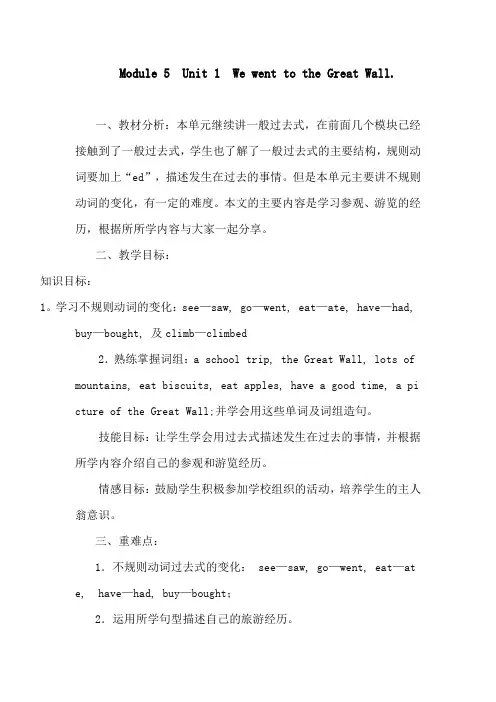
Module 5 Unit 1 We went to the Great Wall.一、教材分析:本单元继续讲一般过去式,在前面几个模块已经接触到了一般过去式,学生也了解了一般过去式的主要结构,规则动词要加上“ed”,描述发生在过去的事情。
但是本单元主要讲不规则动词的变化,有一定的难度。
本文的主要内容是学习参观、游览的经历,根据所所学内容与大家一起分享。
二、教学目标:知识目标:1。
学习不规则动词的变化:see—saw, go—went, eat—ate, have—had, buy—bought, 及climb—climbed2.熟练掌握词组:a school trip, the Great Wall, lots of mountains, eat biscuits, eat apples, have a good time, a pi cture of the Great Wall;并学会用这些单词及词组造句。
技能目标:让学生学会用过去式描述发生在过去的事情,并根据所学内容介绍自己的参观和游览经历。
情感目标:鼓励学生积极参加学校组织的活动,培养学生的主人翁意识。
三、重难点:1.不规则动词过去式的变化: see—saw, go—went, eat—at e, have—had, buy—bought;2.运用所学句型描述自己的旅游经历。
四、教具:U盘,光盘,调查材料五、教学过程:Ⅰ。
热身What day is today?What month is it?What festival is October 1st?I went to Qingdao in the holidays.How about you?Can you tell me where you went?T: I went to Shanghai.Ss: I went to …Do you want to know where Daming and Sam went?Today we will learn Module 5 Unit 1 We went to the Grea t Wall.通过自由交谈既拉近师生距离,又很自然地进入本课的话题。
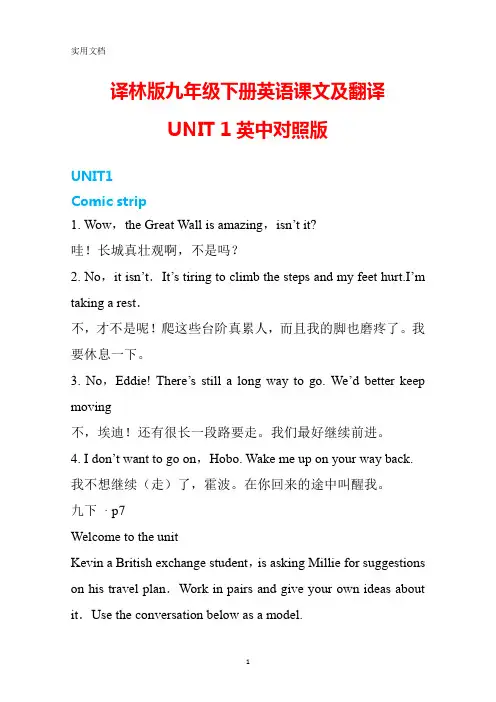
译林版九年级下册英语课文及翻译UNIT 1英中对照版UNIT1Comic strip1. Wow,the Great Wall is amazing,isn’t it?哇!长城真壮观啊,不是吗?2. No,it isn’t.It’s tiring to climb the steps and my feet hurt.I’m taking a rest.不,才不是呢!爬这些台阶真累人,而且我的脚也磨疼了。
我要休息一下。
3. No,Eddie! There’s still a long way to go. We’d better keep moving不,埃迪!还有很长一段路要走。
我们最好继续前进。
4. I don’t want to go on,Hobo. Wake me up on your way back.我不想继续(走)了,霍波。
在你回来的途中叫醒我。
九下· p7Welcome to the unitKevin a British exchange student,is asking Millie for suggestions on his travel plan.Work in pairs and give your own ideas about it.Use the conversation below as a model.凯文一名英国交换生,正在向米莉征求有关他旅行计划的建议。
两人一组活动,就这件事给出你自己的观点。
用下面的对话作为范例。
Kevin:I’m planning to travel around China.Where shall I visit first,Millie? 凯文:我打算环游中国。
米莉,我首先应该参观哪里呢?Millie:Since you’re in Beijing now,why don’t you start from here?Tian’anmen Square,the Palace Museum and the Great Wall are wonderful places to go.米莉:由于你现在就在北京,为什么不从这里开始呢?天安门广场、故宫博物院和长城都是很好的去处。
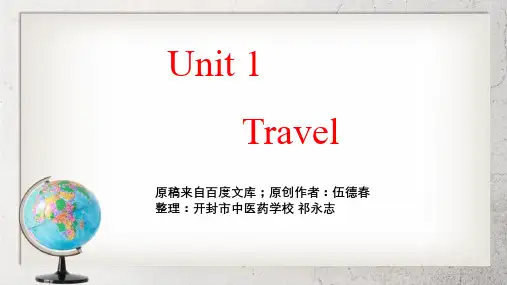
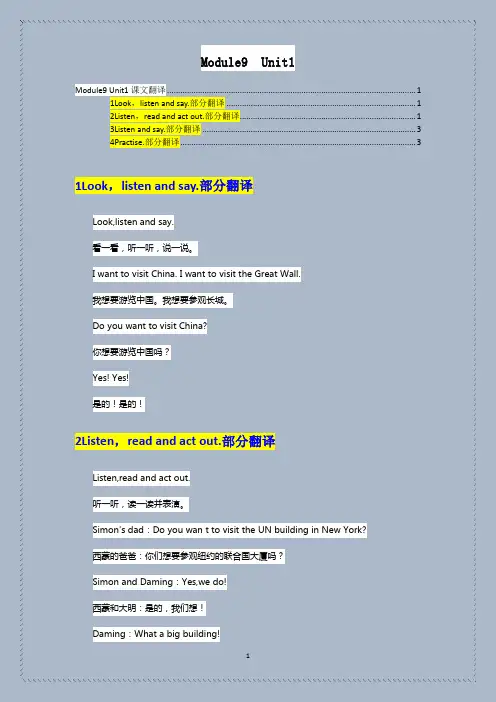
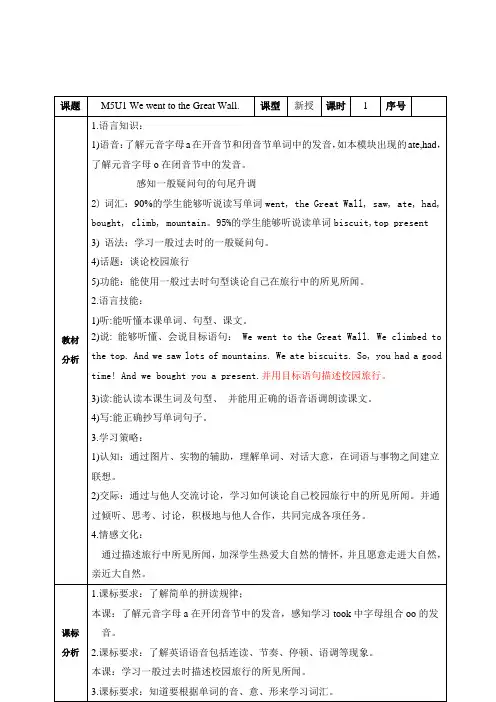
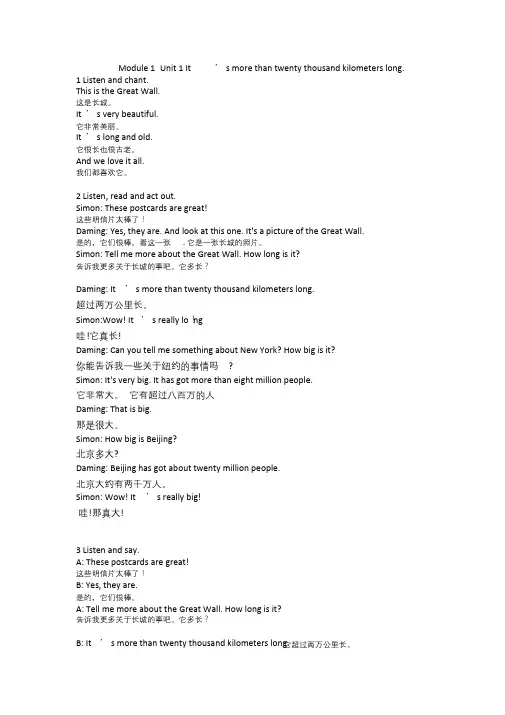
Module 1 Unit 1 It ’s more than twenty thousand kilometers long.1 Listen and chant.This is the Great Wall.这是长城。
It ’s very beautiful.它非常美丽。
It ’s long and old.它很长也很古老。
And we love it all.我们都喜欢它。
2 Listen, read and act out.Simon: These postcards are great!这些明信片太棒了!Daming: Yes, they are. And look at this one. It's a picture of the Great Wall.是的,它们很棒。
看这一张. 它是一张长城的照片。
Simon: Tell me more about the Great Wall. How long is it?告诉我更多关于长城的事吧。
它多长?Daming: It ’s more than twenty thousand kilometers long.超过两万公里长。
Simon:Wow! It ’s really lo!ng哇!它真长!Daming: Can you tell me something about New York? How big is it?你能告诉我一些关于纽约的事情吗?Simon: It's very big. It has got more than eight million people.它非常大。
它有超过八百万的人Daming: That is big.那是很大。
Simon: How big is Beijing?北京多大?Daming: Beijing has got about twenty million people.北京大约有两千万人。

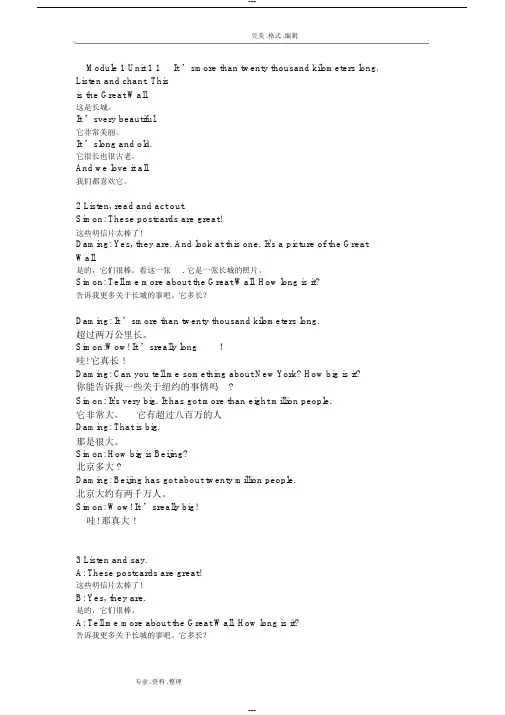
Module 1 Unit 1 1It ’s more than twenty thousand kilometers long. Listen and chant. Thisis the Great Wall.这是长城。
It ’s very beautiful.它非常美丽。
It ’s long and old.它很长也很古老。
And we love it all.我们都喜欢它。
2 Listen, read and act out.Simon: These postcards are great!这些明信片太棒了!Daming: Yes, they are. And look at this one. It's a picture of the Great Wall.是的,它们很棒。
看这一张. 它是一张长城的照片。
Simon: Tell me more about the Great Wall. How long is it?告诉我更多关于长城的事吧。
它多长?Daming: It ’s more than twenty thousand kilometers long.超过两万公里长。
Simon:Wow! It ’s really long!哇! 它真长 !Daming: Can you tell me something about New York? How big is it?你能告诉我一些关于纽约的事情吗?Simon: It's very big. It has got more than eight million people.它非常大。
它有超过八百万的人Daming: That is big.那是很大。
Simon: How big is Beijing?北京多大 ?Daming: Beijing has got about twenty million people.北京大约有两千万人。
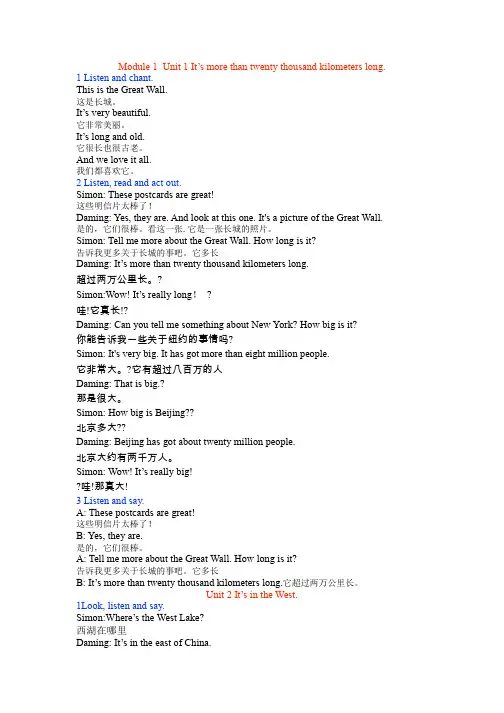
Module 1 Unit 1 It’s more than twenty thousand kilometers long.1 Listen and chant.This is the Great Wall.这是长城。
It’s very beautiful.它非常美丽。
It’s long and old.它很长也很古老。
And we love it all.我们都喜欢它。
2 Listen, read and act out.Simon: These postcards are great!这些明信片太棒了!Daming: Yes, they are. And look at this one. It's a picture of the Great Wall. 是的,它们很棒。
看这一张.它是一张长城的照片。
Simon: Tell me more about the Great Wall. How long is it?告诉我更多关于长城的事吧。
它多长Daming: It’s more than twenty thousand kilometers long.超过两万公里长。
?Simon:Wow! It’s really long! ?哇!它真长!?Daming: Can you tell me something about New York? How big is it?你能告诉我一些关于纽约的事情吗?Simon: It's very big. It has got more than eight million people.它非常大。
?它有超过八百万的人Daming: That is big.?那是很大。
Simon: How big is Beijing??北京多大??Daming: Beijing has got about twenty million people.北京大约有两千万人。
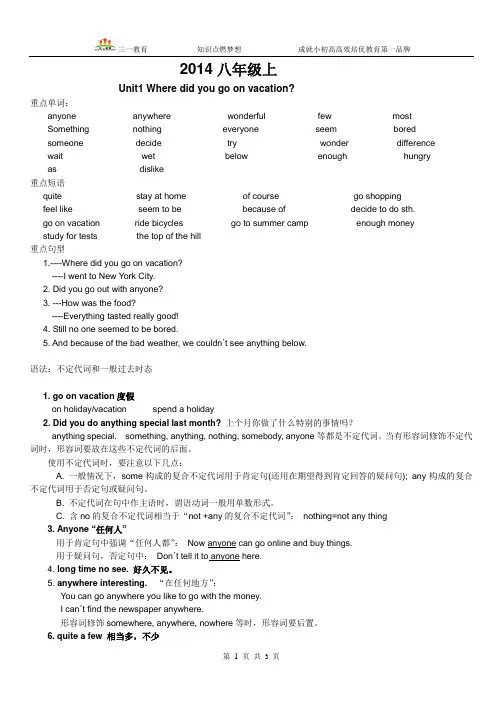
2014八年级上Unit1 Where did you go on vacation?重点单词:anyone anywhere wonderful few mostSomething nothing everyone seem boredsomeone decide try wonder differencewait wet below enough hungryas dislike重点短语quite stay at home of course go shoppingfeel like seem to be because of decide to do sth.go on vacation ride bicycles go to summer camp enough moneystudy for tests the top of the hill重点句型1.----Where did you go on vacation?----I went to New York City.2. Did you go out with anyone?3. ---How was the food?----Everything tasted really good!4. Still no one seemed to be bored.5. And because of the bad weather, we couldn’t see anything below.语法:不定代词和一般过去时态1. go on vacation度假on holiday/vacation spend a holiday2. Did you do anything special last month? 上个月你做了什么特别的事情吗?anything special. something, anything, nothing, somebody, anyone等都是不定代词。
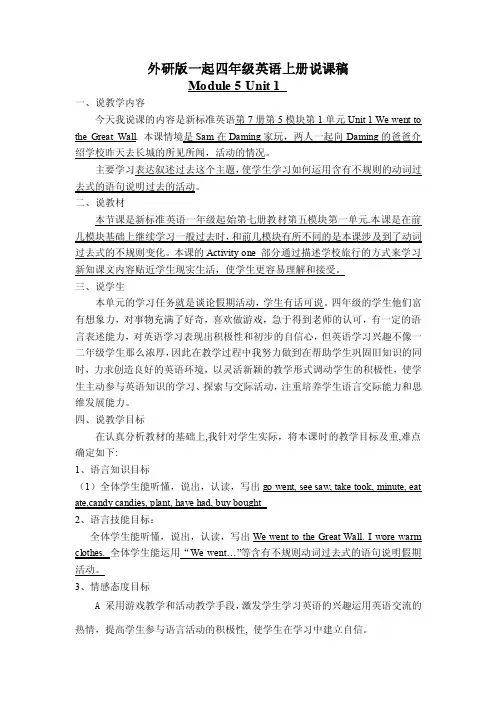
外研版一起四年级英语上册说课稿Module 5 Unit 1一、说教学内容今天我说课的内容是新标准英语第7册第5模块第1单元Unit 1 We went to the Great Wall. 本课情境是Sam在Daming家玩,两人一起向Daming的爸爸介绍学校昨天去长城的所见所闻,活动的情况。
主要学习表达叙述过去这个主题,使学生学习如何运用含有不规则的动词过去式的语句说明过去的活动。
二、说教材本节课是新标准英语一年级起始第七册教材第五模块第一单元.本课是在前几模块基础上继续学习一般过去时,和前几模块有所不同的是本课涉及到了动词过去式的不规则变化。
本课的Activity one 部分通过描述学校旅行的方式来学习新知课文内容贴近学生现实生活,使学生更容易理解和接受。
三、说学生本单元的学习任务就是谈论假期活动,学生有话可说。
四年级的学生他们富有想象力,对事物充满了好奇,喜欢做游戏,急于得到老师的认可,有一定的语言表述能力,对英语学习表现出积极性和初步的自信心,但英语学习兴趣不像一二年级学生那么浓厚,因此在教学过程中我努力做到在帮助学生巩固旧知识的同时,力求创造良好的英语环境,以灵活新颖的教学形式调动学生的积极性,使学生主动参与英语知识的学习、探索与交际活动,注重培养学生语言交际能力和思维发展能力。
四、说教学目标在认真分析教材的基础上,我针对学生实际,将本课时的教学目标及重,难点确定如下:1、语言知识目标(1)全体学生能听懂,说出,认读,写出go went, see saw, take took, minute, eat ate,candy candies, plant, have had, buy bought2、语言技能目标:全体学生能听懂,说出,认读,写出We went to the Great Wall. I wore warm clothes. 全体学生能运用“We went…”等含有不规则动词过去式的语句说明假期活动。
Unit1 The Great Wall长城知识详解重难点1.你会夸赞这些东西很棒吗?—These…are great!课文应用:These postcard are great!这些明信片太棒了!句型结构These+可数名词复数+are great!重点解析these意为“这些”,后面要接可数名词复数形式。
因为此句型中的主语是可数名词复数形式,所以be动词用are。
great意为“美妙的;好极的”。
生活实例Gao Ming看了朋友收集的一些邮票,他觉得这些邮票太棒了。
让我们来看一看Gao Ming是怎样表达的:知识链接含义丰富的“great”表示“大的;巨大的”。
例如:There is a great tree in front of our house.我们的屋前有一棵大树。
表示“伟大的;优秀的”。
例如:Einstein is a great scientist.爱因斯坦是一位伟大的科学家。
表示“美妙的;好极的”。
例如:What a great idea!多么好的一个主意啊!That sounds great!那听起来好极了!可数名词和不可数名词在英语中,名词按它们所表示的事物的性质不同可以分为可数名词和不可数名词。
不可数名词是指不能以数目来计算的词,一般没有复数形式。
例如:work工作,meat肉。
可数名词是指能以数目来计算的词,因此它有复数形式。
其复数形式的变化有以下几种情况(详见下表):少数名词复数形式的变化是不规则的。
例如:man-men男人,woman-women女人,tooth-teeth牙齿,child-children儿童。
2.如何表达“它是一张……的照片”-It's a picture of...课文应用:It's a picture of the Great Wall.它是一张长城的照片。
句型结构It's a picture of+某人/某物.重点解析picture在这个句型中的意思是“照片”,相当于photo。
Module 1 AmericaUnit 1 The Great Wall编写人田野【教材分析】本课是外研社《新标准英语》三年级起点第七册第一模块的第一单元的教学内容,是语言呈现课,以谈论明信片为导线,引出长城,北京,纽约等话题,学习怎样谈论一个地方,例如北京的面积和人口。
学生通过本课的学习要认识本课的生词,并能书写部分单词。
能够用本课的目标语句说明历史古迹。
小学六年级学生应该能够阅读简单的英语对话及课文,学生通过本课的学习要认识本课的生词,能够用本课的目标语句说明历史古迹。
【教学目标】知识与技能:学习本课的目标语句:How long is it?It‘s about six thousand and seven hundred kilometers.能识别Postcard, more, thousand, kilometer, million,并能书写 about。
过程与方法:能通过阅读,理解课文引发学生思考和了解中国长城和其它历史古迹以及中国的古老文化。
情感、态度与价值观:通过本课的学习,学生了解了我国的伟大建筑万里长城,培养学生热爱祖国,热爱祖国的大好河山。
【教学重难点】1.重点1)学会听、说句子These postcards are great!It’s a picture of the Great Wall.2)运用Tell me more的说话操练来了解The Great Wall , New York, Beijing等情况。
2.难点1)流利说一些简单的表达It ’s very big.It’s got --- .That is big.That’s a lot.2)了解关于数词的表达about eight million people ,about six thousand seven hundred kilometers【课时安排】安排一课时完成教学任务【教学过程】1.导入新课老师热情地问候学生们,欢迎他们在暑假过后回到学校。
中职英语u n i t1T h e-G r e a t-W a l l教学设计(总11页)-CAL-FENGHAI.-(YICAI)-Company One1-CAL-本页仅作为文档封面,使用请直接删除The Great Wall教学设计一.教材分析 Analysis of teaching material(一)教材地位和教学内容分析地位和作用Status and Function:本节教学内容选自语文出版社出版,由王立善、戴宗显主编的英语基础模块下册Unit1 Travel 阅读内容。
本单元起到衔接上、下册教材的作用。
阅读部分承载着整个单元中最重要的语言和文化信息,是教师在整个教学过程中需要重点处理的部分,也是学生进一步巩固和提高英语水平的依托.内容: 本节课的语言知识和技能都是围绕长城展开,通过对这个话题的讨论和学习,使学生学会相关的词汇和句型;提高学生英语阅读理解和归纳信息的能力;同时使学生了解长城的历史,激发他们的爱国热情和民族自豪感。
教材特点:工具性、人文性、交际性、话题性和实践性设计理念:融阅读教学于话题情景中,以教师为主导,学生为主体,以任务型教学法为主线,教师在教学过程中应与学生积极互动,共同发展,要处理好传授知识与培养能力的关系。
课型:阅读新授课课时: 1课时(二)学情分析:Analysis of students对象:中职高二护理班学生学生特点:不善言辞,学习基础薄弱,他们自认为是被社会、学校所忽略了的群体,学习缺乏积极性和主动性,但他们渴望得到提升。
知识储备:具备初步的阅读能力并课前已学习了本单元的词汇。
(三)教学目标和要求 Teaching aims and Demands语言知识目标、语言技能目标和情感态度目标。
1.语言知识目标:Knowledge objects1)掌握下列单词:beacon tower ,dragon,dynasty protect,remember,carry,excited 等词。
【教材原文】What do you think of talk shows? 你认为访谈节目怎么样?“What do you think of...?”意为“你认为……怎么样?”,常用来询问对方对某人或某事的看法或观点等,相当于“How do you like...?”。
但要注意,这两个句型中的特殊疑问词what和how 不可以混用。
例如:What do you think of the movie theater?=How do you like the movie theater?你认为这个电影院怎么样?例1、—____do you___the TV show? —It is interesting.A、How; thinkB、How; likeC、What; likeD、What; think 【解析】How do you like...?相当于What do you think of...?意为“你认为……怎么样?”,是固定句型。
故选B.【教材原文】I don’t mind them. 我不介意它们。
mind用作动词时,意为“介意;在乎”,后可接名词、代词或动词-ing形式。
如:I don’t mind the noise. 我不介意这噪音。
Would you mind closing the door? 你介意关上门吗?例2、—The wind is blowing heavily outside. Would you mind ______the window?—Of course not.A、openB、closeC、openingD、closing【解析】句意:——外面风吹得很大,你介意关上窗户吗?——当然不介意。
mind doing sth. 意为“介意做某事”,为固定搭配。
故选 D. 【教材原文】Do you plan to watch the news tonight? 今晚你打算看新闻吗?plan在此处作动词,意为“计划,打算”。